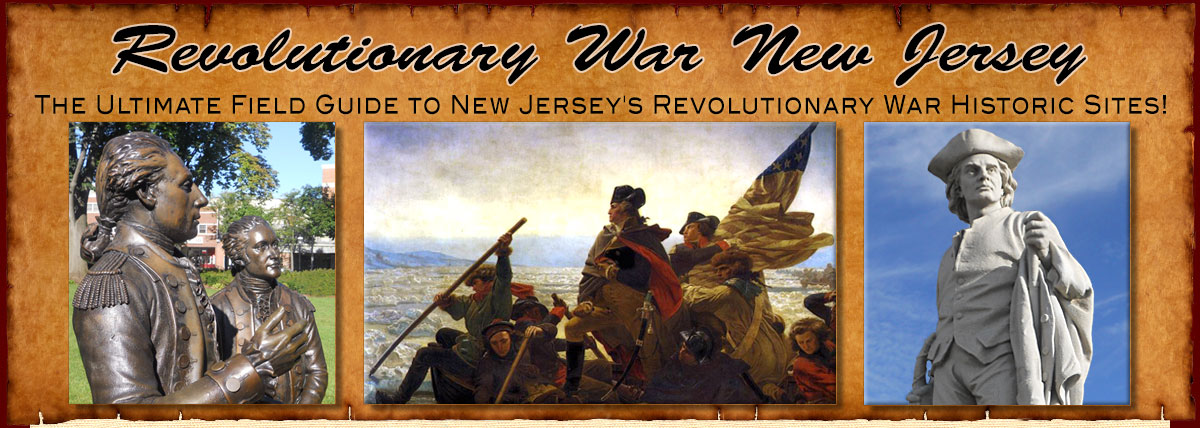

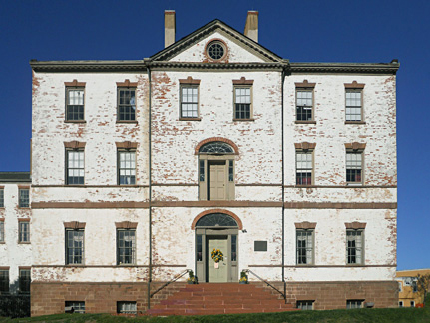
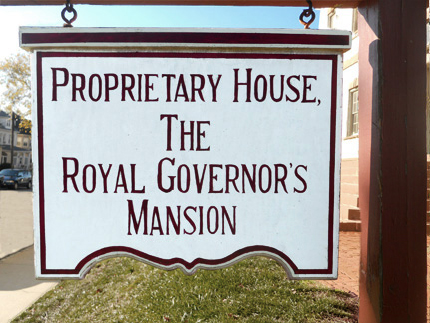
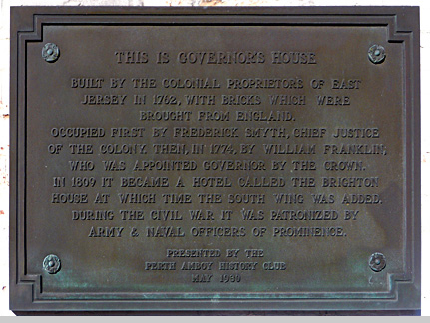
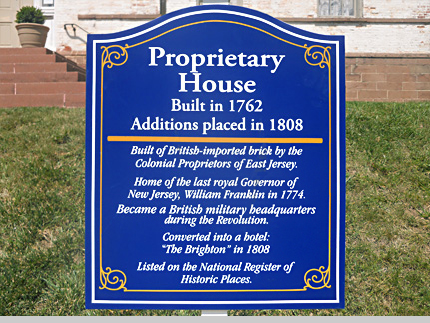
Proprietary House
149 Kearny Avenue
Map / Directions to Proprietary House
Map to all Perth Amboy Revolutionary War Sites
For more about information about the Proprietary House, including tour information,
see the Proprietary House Website
Royal Governor William Franklin - Son of Benjamin Franklin [1]
William Franklin was born circa 1730, the illegitimate son of Benjamin Franklin. His mother's identity is unknown, but Benjamin and his common-law wife Deborah Read raised him as their son. William was close with his father growing up and as a young man. He participated in his father's famous kite-flying electricity experiment in 1752.
William Franklin began serving as the Royal Governor of New Jersey in 1763. [2] At that time, New Jersey was still a British colony, with a Royal Governor who was appointed by the King of England. There were two capitals of New Jersey then, Perth Amboy in the east and Burlington in the west. During his first eleven years as governor, William lived in an estate in Burlington. Then in 1774, he moved to Perth Amboy to live at Proprietary House.
During William's years as Royal Governor of New Jersey, the tensions that would lead to the Revolutionary War grew throughout all thirteen colonies. Feelings were mixed, some people sided with Independence, while others remained loyal to Britain. This choosing of sides sometimes caused rifts within families, as it would within the Franklin family.
Shortly after the Revolutionary War began in 1775, Benjamin and William met to discuss their positions regarding Independence. It was clear that neither man would be swayed from the path they had chosen. Benjamin was committed to being fully politically active in the American cause of Independence; William was committed to continuing as the Royal Governor and remaining Loyal to Britain. The two met again briefly that November, which would turn out to be their last meeting until the end of the war. Each man remained true to the side they had chosen, and events were quickly developing that would break them apart permanently.
1776 - Governor William Franklin is Arrested at Proprietary House [3]
As the advocates of Independence grew in importance and influence, a governing body was formed in New Jersey to supersede the authority of the Royal Governor. The body was called the Provincial Congress of New Jersey, and in January 1776, they ordered William Franklin to be placed under house arrest at Proprietary House. He would remain under house arrest at Proprietary House with his wife Elizabeth for the next five months, as the Revolutionary War went on and the United States moved closer to declaring independence.
On June 3, while still under house arrest, William Franklin tried to reassert his power by calling on the New Jersey Assembly to meet with him. Eleven days later, Provincial Congress of New Jersey stated that Franklin's call "ought not to be obeyed."
Twelve days later, the Provincial Congress of New Jersey ordered militia officer Nathaniel Heard to go to Proprietary House to present William Franklin with an option. William could either be placed under arrest, or he could sign a parole in which he would agree to step down from the governorship and leave Perth Amboy to stay peaceably at Princeton, Bordentown, or at farm property which William owned in Willingboro.
Heard arrived at the Proprietary House the following day to present William Franklin with his options, to which William stated that he "absolutely refused" to sign the parole. Heard left a group of about sixty to guard William at Proprietary House, and sent word to the Provincial Congress asking what he should do next. He received a reply that he was to arrest William and bring him to Burlington, where the Provincial Congress of New Jersey was then convened.
Heard and a group of militiamen returned to the Proprietary House on June 19 and placed William Franklin under arrest. William's wife Elizabeth was left behind at the Proprietary House, where she would continue to live for another year. The couple would never see each other again.
William was taken to Burlington, where he faced a hearing in front of the New Jersey Provincial Congress. William was defiant at the hearing. He rejected the authority of the New Jersey Provincial Congress and told them to "do as you please, and make the best of it."
The New Jersey Provincial Congress then waited for word from the Continental Congress in Philadelphia as to what should be done with William Franklin.(The Continental Congress was a representative body from all thirteen colonies, which is why the New Jersey Provincial Congress deferred to their judgment in this matter.)
On June 25, they received word from the Continental Congress that William Franklin should be removed from New Jersey and taken to East Windsor, Connecticut. Just nine days later, the Declaration of Independence was adopted in Philadelphia by the Continental Congress, which included William's father Benjamin.
William continued to be held prisoner in Connecticut until 1778. During that time, his wife Elizabeth had left the Proprietary House to live in British-occupied New York City where she died shortly after. William, held prisoner in Connecticut, was unable to attend her funeral.
When William was released in a prisoner exchange with the British in 1778, he then went to British-occupied New York City, where he spent the rest of the war. After the war ended, he moved to Britain, where he lived the rest of his life.
Postscript [4]
Benjamin and William only saw each other one time after the end of the war, when they met in London in 1785. The purpose of the meeting was not to heal the rift between them, but to sort out some business and financial matters, including the property which William owned in Willingboro.
The two men never reconciled as father and son, and they never spoke again.
Benjamin died in Philadelphia in 1790, and William died in London in 1813.

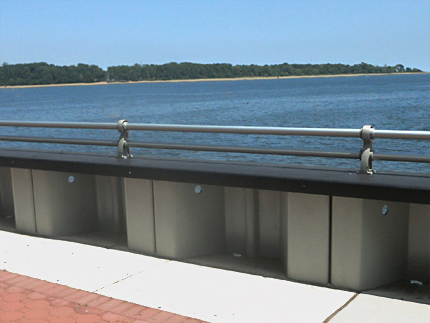
The Bluff
Water St.
Map / Directions to the Bluff
Map to all Perth Amboy Revolutionary War Sites
Perth Amboy's location was a major factor in its experience in the Revolutionary War. It is located less than a mile across the water from Staten Island.
Staten Island, along with Manhattan and Long Island, was occupied by British forces for most of the Revolutionary War.
The body of water between Perth Amboy and Staten Island is known as the Arthur Kill. (A kill is a term for a creek which derives from a Dutch word "kille" meaning "riverbed" or "water channel.")
The area in Perth Amboy along the water is known as the Bluff. The picture at right was taken at the Bluff looking out towards Staten Island, which is clearly visible across the Arthur Kill.
Five Revolutionary War-era events related to the Bluff are described below:
October 1723
A Half-Century before the Revolutionary War began,
Seventeen Year-Old Benjamin Franklin lands at Perth Amboy, en route to Philadelphia [5]
Benjamin Franklin was born in 1706 in Boston. At the age of twelve, he was apprenticed to his older brother Joseph in his print shop. Young Benjamin learned the printing trade, and he also began his writing career for Joseph's newspaper, The Courant. However, Joseph mistreated Benjamin and even physically beat him. In 1723, when Benjamin was seventeen, he decided to run away from his brother and his apprenticeship.
He took a ship from Boston to New York City, where he hoped to find work as a printer. In New York City, he met the owner of a print shop who told him that he had no need for another worker at that time, but he advised Benjamin to head to Philadelphia to find work.
Franklin traveled by boat to Perth Amboy, and then proceeded to walk fifty miles to Burlington to take a boat to Philadelphia, located across the Delaware River. In Philadelphia, Benjamin Franklin began his remarkable career, in which he would become successful in publishing, writing, business, politics, diplomacy, and science.
When the Revolutionary War began in 1775, Benjamin Franklin was nearly seventy years old and his landing on the bluff in Perth Amboy was five decades behind him. However, his career was far from over, and he became one of the central political and diplomatic figures of the Revolutionary War era. He signed both the Declaration of Independence and the United States Constitution. He was a member of the Continental Congress. His diplomacy with France during the war helped to ensure French support to the American side in the war, in the form of financial loans and military troops, both of which played a crucial role in the American victory.
July 1776
Revolutionary War Exchange of Cannon Fire Damages the St. Peter's Church
[6]
In July 1776, an exchange of cannon fire occurred between American forces in Perth Amboy and British forces across the Arthur Kill. Damage was done to St. Peter's Episcopal Church and its cemetery, which are located less than three-hundred yards from the water's edge. (See the St. Peter's Episcopal Church and Cemetery entry below on this page.)
September 1776
Benjamin Franklin, John Adams and Edward Rutledge cross the Arthur Kill
to Meet with British Admiral Richard Howe in Staten Island [7]
On September 2, 1776, the Continental Congress, meeting in Philadelphia, received word that British Admiral Richard Howe wished to meet with several of their members to discuss the prospect of peace negotiations. On September 6, the Continental Congress appointed a three-man committee from among their members to meet with Howe on Staten Island. The chosen committee consisted of Benjamin Franklin, John Adams, and Edward Rutledge.
On September 9, Franklin, Adams, and Rutledge left Philadelphia to head across New Jersey to Perth Amboy, where they were to be taken by boat across the Arthur Kill to Staten Island to meet with Howe. Along the way they stayed a night at the Indian Queen Tavern in New Brunswick. They arrived in Perth Amboy on September 11, where they found that Howe had sent a British officer over from Staten Island to act as a hostage to ensure the safe return of Adams, Franklin and Rutledge from behind British lines. The three men found this unnecessary, and insisted that the hostage come with them to Staten Island.
Adams' own description of the incident reads: [8]
(Adams' spelling, punctuation, and capitalization are left unchanged)
"Lord How had sent over an Officer as an Hostage for our Security. I said to Dr. Franklin, it would be childish in Us to depend upon such a Pledge and insisted on taking him over with Us, and keeping our Surety on the same side of the Water with Us. My Colleagues exulted in the Proposition and agreed to it instantly. We told the Officer, if he held himself under our direction he must go back with Us. He bowed Assent, and We all embarked in his Lordships Barge. As We approached the Shore his Lordship, observing Us, came down to the Waters Edge to receive Us, and looking at the Officer, he said, Gentlemen, you make me a very high Compliment, and you may depend upon it, I will consider it as the most sacred of Things. We walked up to the House between Lines of Guards of Grenadiers, looking as fierce as ten furies, and making all the Grimaces and Gestures and motions of their Musquets with Bayonets fixed, which I suppose military Ettiquette requires but which We neither understood nor regarded.
"The House had been the Habitation of military Guards, and was as dirty as a stable: but his Lordship had prepared a large handsome Room, by spreading a Carpet of Moss and green Spriggs from Bushes and Shrubbs in the Neighbourhood, till he had made it not only wholesome but romantically elegant, and he entertained Us with good Claret, good Bread, cold Ham, Tongues and Mutton."
The meeting with Howe did not lead to any successful peace negotiations, and Franklin, Adams, and Rutledge returned to Perth Amboy and then headed back to the Continental Congress in Philadelphia.
One can only wonder at the thoughts of Benjamin Franklin during this time in Perth Amboy. As described in the Proprietary House entry above, his own estranged son William had been arrested less than three months before in Perth Amboy for remaining loyal to the British, while he had chosen the side of American Independence.
The scene of Benjamin Franklin, John Adams, and Edward Rutledge at the Bluff, waiting to be rowed over to Staten Island, is depicted in a stained glass window at St. Peter's Church in Perth Amboy. (See the St. Peter's Episcopal Church and Cemetery entry below.)
The Staten Island house where Adams, Franklin, and Rutledge met with Howe is now a museum known as the Conference House. For more information about the Conference House, visit www.conferencehouse.org.
June 1777
The Battle of the Short Hills [9]
From December 1776 - June 1777, British troops occupied New Brunswick, which is located ten miles to the west of Perth Amboy. During this time, the Continental (American) Army was encamped behind the safety of the Watchung Mountains, first in Morristown and then in Middlebrook.
After unsuccessfully trying to lure the Continental Army out of the mountains to fight, British General William Howe (the brother of Admiral Richard Howe) brought all of the British forces in and around New Brunswick to Perth Amboy, to be carried by boats to Staten Island. This drew some of the Continental Army down out of the mountains into the flatlands below. In the early morning darkness of June 26, Howe reversed course and attempted a sneak attack on the Continental Army, resulting in the Battle of the Short Hills being fought that day throughout Woodbridge, Edison, and Scotch Plains. The British attack was unsuccessful; although the Continental Army suffered casualties, they were able to retreat into the Watchung Mountains. The British troops then returned to Perth Amboy and left by boat for Staten Island by June 30.
July 1804
Aaron Burr arrives at the Bluff, 11 Days After His Duel With Alexander Hamilton [10]
On July 11, 1804, twenty-one years after the Revolutionary War ended, Alexander Hamilton and Aaron Burr fought a duel in Weehawken. The two men were both Revolutionary War veterans who played prominent roles in the politics of the new country after the Revolutionary War ended. Hamilton had served as the country's first Secretary of the Treasury under President George Washington. Burr was the sitting Vice-President at the time of the duel.
In 1804 both Hamilton and Burr lived in New York City. On the morning of July 11, the two each crossed the Hudson River by boat to Weehawken to duel. Hamilton was fatally wounded; he was brought back to New York, where he died the following day. Burr also returned to New York City. He was unharmed, but the public reaction to the news of Hamilton's death made him decide to leave New York. On the night of July 21, Burr left New York City by boat.
The following morning, Sunday July 22, Burr arrived unexpectedly at the home of his friend Commodore Thomas Truxton, whose property was located at the Bluff in Perth Amboy. Burr asked if Truxton could help him obtain horses to continue his travels. Truxton told Burr that it would be difficult to obtain the horses on a Sunday, and so Burr spent the night at Truxton's house. The following morning, Truxton took Burr to Cranbury, NJ, where Burr hired horses and a carriage, and proceeded on to Philadelphia.
Commodore Truxton's house on the Bluff was demolished in 1935.


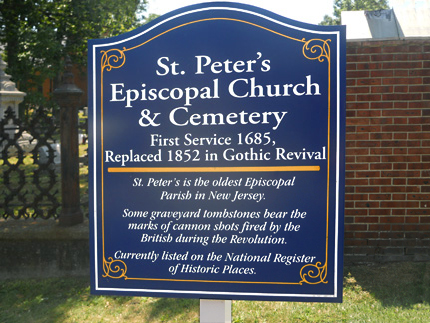
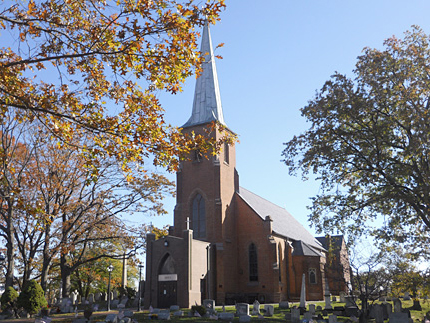
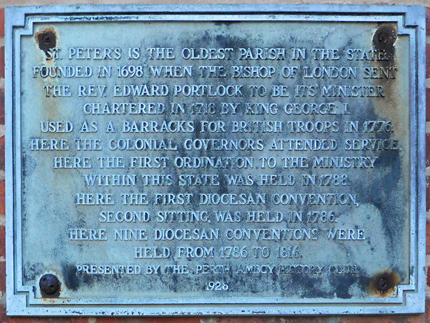
St. Peter's Episcopal Church
183 Rector Street
Map / Directions to St. Peter's Episcopal Church
Map to all Perth Amboy Revolutionary War Sites
The current St. Peter's Episcopal Church building was built in 1852. It replaced an earlier church structure built at this site in 1722 which was greatly affected by the Revolutionary War.
The following description of the Revolutionary War damage to the church is from a 1924 book, A History of St. Peter's Church in Perth Amboy: [11]
"During the war the church was roughly treated. The fences around the church were burned by the soldiers for firewood, and the pews of the church and even the flooring were broken up for the same purpose. All the glass had been broken from the windows and shutters were used to keep out the cold. The church was used for stabling horses and as a barracks for soldiery, American and British forces using it in turn, as the town came into the lines either of the American or the British forces. The gravestones were used to make soldiers' ovens and to serve for tables in the preparation of their meals. "
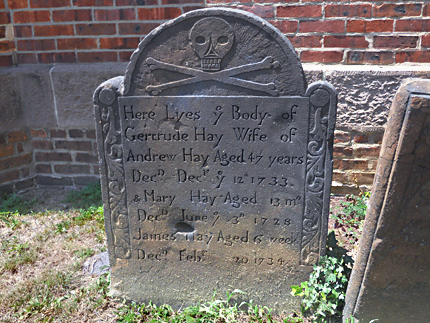
In July 1776, an exchange of cannon fire occurred between American forces in Perth Amboy and British forces across the Arthur Kill.
Damage was done to the church and to gravestones in the cemetery. The upper part of the gravestone of a man named William Bryant was knocked down. Bryant's gravestone is no longer standing. [12]
The photo at left shows a tombstone which is still standing that has the impact mark of being hit by a cannonball.
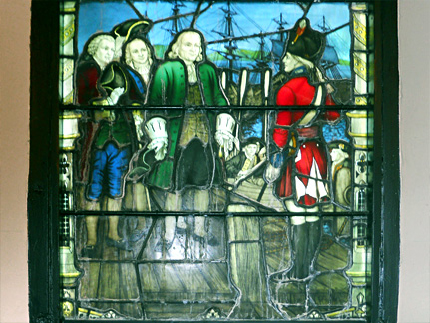
Stained Glass Windows
The church has several impressive stained glass windows which depict historical events associated with the church or Perth Amboy. [13]
One of the windows is shown in the photo on the left. It depicts John Adams, Benjamin Franklin, and Thomas Rutledge in Perth Amboy on September 11, 1776. They are shown waiting to be taken across the Arthur Kill to Staten Island, where they would meet with the British Admiral Richard Howe to discuss peace negotiations. The figure in red is the British officer sent by Howe as a hostage.
This event is described in more detail in The Bluff entry above on this page.


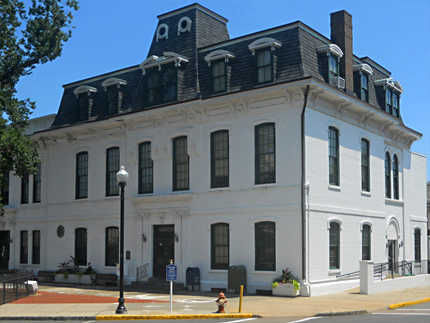
City Hall
260 High St.
Market Square
Across from City Hall / High St. and Market St.
Map / Directions to City Hall and Market Square
Map to all Perth Amboy Revolutionary War Sites
City Hall
Perth Amboy City Hall was first built circa 1714. It has gone through a number of changes, rebuildings, and additions since then, but portions of the original structure remain. A sign in front of City Hall refers to it as "The oldest public building in continuous use in the United States." [14]
The New Jersey Legislature met here in 1789-1790. On November 20, 1789, they ratified the first ten amendments to the United States Constitution, which are known as the Bill of Rights. New Jersey was the first of the then-thirteen states to do so. [15] This historic first is commemorated by the Bill of Rights Arch in Market Square, a park across the street from City Hall.
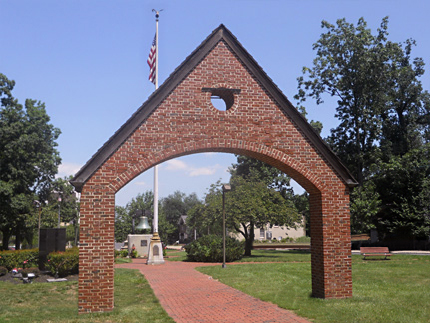
Bill of Rights Arch
The Bill of Rights Arch was dedicated November 20, 1989, the 200th Anniversary of New Jersey's ratification of the Bill of Rights.
The arch is a reconstruction of a wall belonging to a market house which stood here in the 1700's. A plaque in the park describes it as "an authentic reconstruction of the south portal entry of the original market building, which was a roof covered open air structure that measured approximately 20 feet wide by 100 feet long." [16]
During the Revolutionary War, the open sections of the market house were boarded up and the building was used as a barracks for soldiers. The market was torn down in 1842. [17]
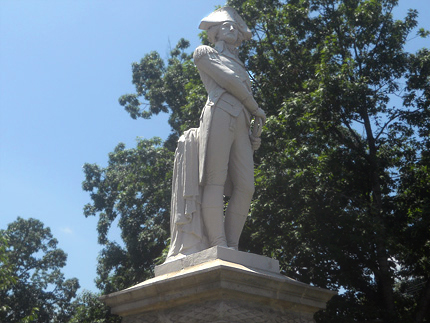
George Washington Statue
This statue of George Washington was a gift to Perth Amboy from its citizens of Scandinavian descent. It was unveiled at a ceremony on February 22, 1896. [18]
The statue was sculpted by Nels Alling, who was born in Denmark and immigrated to the United States in 1887 at the age of twenty-six. After living in Long Island for two years, he moved to Perth Amboy in 1889, where he lived and worked for decades. After he retired from sculpting, he lived nearby in the Fords section of Woodbridge, where he died at the age of 94 on March 8, 1955. [19]
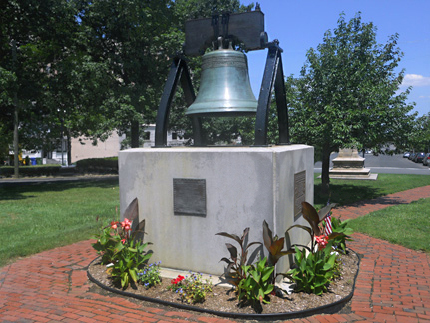
Liberty Bell Reproduction
Market square also has a reproduction of the Liberty Bell. It is one of fifty-three reproductions which were cast in 1950. The reproductions were commissioned by the United States Treasury as part of a savings bond drive, and were cast in France. The bells were given to each of the fifty United States, Washington, D.C. and two United States territories.
This reproduction was displayed throughout New Jersey between May 15 and July 4, 1950, as part of the savings bond drive, before making its permanent home here. [20]
The original Liberty Bell can be seen at the Liberty Bell Center within Independence National Historical Park in Philadelphia.

1. ^ Biographical details of William Franklin's life and service as Royal Governor were drawn from a number of secondary sources, mainly:
• Walter Isaacson, Benjamin Franklin, An American Life (New York: Simon & Schuster, 2003)
• Larry R. Gerlach, New Jersey's Last Royal Governor (#13 in New Jersey's Revolutionary Experience series) (Trenton: New Jersey Historical Commission, 1975)
2. ^ William Franklin was actually appointed as the New Jersey Governor in September 1762, while in London.
He did not leave London to return to America until January 1763, arriving in Philadelphia on February 20.
On February 25, he came to Perth Amboy, where there was a ceremony when he took the oath of office.
On March 3, he came to Burlington, where there was another ceremony in his honor.
These events are chronicled in contemporary newspaper accounts from these months, which are reprinted in:
William Nelson, Editor, Archives of the State of New Jersey, First Series, Volume XXIV (Paterson, NJ: The Call Printing and Publishing Co., 1902) Pages 103, 132, 136, 138, 139, 140, 144, 146, 147, 152-153 (A notice about William Franklin's Sept. 5, 1762 wedding appears on page 104)
Available to be read at the Internet Archive here
3.^ The events of January - June 1776, before, during and after the arrest of William Franklin, are recorded in:
Minutes of the Provincial Congress and the Council of Safety of the State of New Jersey (Trenton: Naar, Day & Naar, 1879) pages 454 - 475
Available to be read at the Internet Archive here
Secondary sources consulted include:
• Walter Isaacson, Benjamin Franklin, An American Life (New York: Simon & Schuster, 2003)
• Larry R. Gerlach, New Jersey's Last Royal Governor (#13 in New Jersey's Revolutionary Experience series) (Trenton: New Jersey Historical Commission, 1975)
• Larry R. Gerlach, Prologue to Independence - New Jersey in the Coming of the American Revolution (New Brunswick: Rutgers University Press, 1976)
• William Randall, A Little Revenge - Benjamin Franklin and His Son (Boston and Toronto: Little, Brown & Company, 1984)
4. ^ Walter Isaacson, Benjamin Franklin, An American Life (New York: Simon & Schuster, 2003) Pages 434-435
5. ^ Benjamin Franklin told the story of his running away from Boston, and his journey through New York City, Perth Amboy, Burlington, and Philadelphia in his Autobiography. In the Signet Classic paperback edition of Benjamin Franklin The Autobiography and Other Writings, the story appears on pages 34-37.
6. ^ See the "Cemetery" section of the St. Peter's Church and Cemetery entry on this page, and its accompanying Source Note # 12 below.
7. ^ The message from Howe was delivered to the Continental Congress by American General John Sullivan. Sullivan had been captured by the British and was being held as a prisoner of war. He was paroled in order to deliver the message to the Continental Congress on September 2, 1776. Congress's handling of the situation prior to sending the three-man committee, and after their return, can be traced in:
• Journals of the American Congress from 1774-1788, Volume I (Washington D.C.: Way and Gideon, 1823) Pages 462-466, 473, and 477-478
Available to be read at Google Books hereJohn Adams' descriptions of the events surrounding the meeting with Howe can be read in:
• “[Monday September 9, 1776.] ,” Founders Online, National Archives (http://founders.archives.gov/documents/Adams/01-03-02-0016-0187 [last update: 2015-12-30]). Source: The Adams Papers, Diary and Autobiography of John Adams, vol. 3, Diary, 1782–1804; Autobiography, Part One to October 1776, ed. L. H. Butterfield. Cambridge, MA: Harvard University Press, 1961, pp. 417–420.
•“[Tuesday. September 17th. 1776.] ,” Founders Online, National Archives (http://founders.archives.gov/documents/Adams/01-03-02-0016-0189 [last update: 2015-12-30]). Source: The Adams Papers, Diary and Autobiography of John Adams, vol. 3, Diary, 1782–1804; Autobiography, Part One to October 1776, ed. L. H. Butterfield. Cambridge, MA: Harvard University Press, 1961, pp. 420–431.
8. ^ “[Monday September 9, 1776.] ,” Founders Online, National Archives (http://founders.archives.gov/documents/Adams/01-03-02-0016-0187 [last update: 2015-12-30]). Source: The Adams Papers, Diary and Autobiography of John Adams, vol. 3, Diary, 1782–1804; Autobiography, Part One to October 1776, ed. L. H. Butterfield. Cambridge, MA: Harvard University Press, 1961, pp. 417–420.
9. ^ For more information and accompanying source notes about the events of June 1777, see:
• The Hillsborough Reformed Church and Cemetery entry on the Millstone page of this website
• The Franklin Inn/ Annie Van Liew's House entry on the Franklin Township page of this website
• The Battle of Short Hills entry on the Scotch Plains page of this website
10. ^ Commodore Truxton's account of Burr's arrival and stay in Perth Amboy is quoted in:
James Parton, The Life and Times of Aaron Burr, Volume II (Boston: Houghton, Mifflin and Company, 1888) Pages 15-18
Available to be read at the Internet Archive here• Information that Truxton's house was demolished in 1935 was drawn from the NJ Coastal Heritage Trail The Bluff: Witness to History historic plaque.
11. ^ William Northey Jones, The History of St. Peter's Church in Perth Amboy, New Jersey (1924) Pages 76-77
12. ^ An exchange of cannon fire which affected Perth Amboy did occur on July 25, 1776, and it is likely that the damage to the cemetery occurred at that time. However, based on the sources listed below, there is some uncertainty as to the circumstances of that day's cannon fire exchange, and as to whether the damage to the cemetery occurred on that day or on another day.
• New York Gazette and Weekly Mercury, July 29, 1776, reprinted in:
William S. Stryker, editor, Archives of the State of New Jersey, Second Series, Vol. I (Documents Relating to the Revolutionary History of the State of New Jersey) (Trenton: John L, Murphy Publishing Company, 1901) page 154
Available to be read at the Internet Archive hereThe article contains the following text:
"Several Cannon were fired last Thursday Afternoon [July 25, 1776], from our Battery at Amboy, at a Number of Boats from Staten Island, bound to Sandy-Hook, supposed to join Part of the Ministerial Fleet laying there; This brought on a Cannonade from the Encampment of the Regulars [British troops] near Billop's Point, on the Island, which continued very hot on both Sides for near an Hour; The Boats got clear, but many of the Regulars were seen to fall, and several carried off, supposed to be wounded. On our Side, a Soldier belonging to one of the Philadelphia Battalions was Killed, and one wounded; a Horse in a Carriage had his Head shot off in the Street, and some Damage was done the Houses."
This article does not specifically mention the church or the cemetery. However, it is likely that some damage would have been done to them, based on the facts that Billop's Point is almost directly across the Arthur Kill from the church and that the exchange of cannon fire is described as having lasted almost an hour.
• Rev. Timothy Alden, A Collection of American Epitaphs and Inscriptions, with Occasional Notes, Volume V (New York: 1814) Pages 224-225
Available to be read at the Hathi Trust Digital Library website hereThis book quotes the inscription from the gravestone of William Bryant and then goes on to state, "The upper part of the headstone, on which were a few words of this inscription, was broken off by a cannon ball from a British armed vessel, in the late revolutionary war, which also struck and entered the episcopal church."
The text does not specify a date during the war when this damage occurred. The phrase, "the late revolutionary war," most likely does not mean in the latter part of the war. The author uses the term "late" many other times in this book to mean former, preceding, or in the past. It is therefore likely that he is using the word "late" the same way in this instance.
This book is the earliest source which I could locate mentioning the damage to the church and cemetery. The book was published in 1814, thirty-eight years after 1776.
• William Adee Whitehead, Contributions to the Early History of Perth Amboy and Adjoining Country (New York: D. Appleton & Company, 1856) Pages 330-331
Available to be read at the Internet Archive here♦ The text of this book states the following. Note that prior to these paragraphs, it discussed events which occurred on July 4 and July 5, 1776.
"It was about this period that a British brig of war, mounting 12 guns, entered the harbor and anchored off St. Peter's Church, about midway between the two shores. The Americans at night procured from Woodbridge an eighteen-pound gun, placed it behind the breastwork by the church, and, when morning dawned, opened a fire upon the vessel. It was returned, but being so near the shore she was obliged to consult her safety by retiring; she would otherwise have been sunk. Probably it was at this time that the tombstone of Captain William Bryant, in the rear of the church, was broken off by a ball; which was the case, so says tradition, some time during the Revolution.
"The ball, which left its mark in the east end of the old church was fired from a vessel lying the other side of Billop's Point. The English kept a vessel almost constantly there for the convenience of traders; and it is said some of the ancestors of the present population derived considerable profit by trafficking with this vessel in a neutral character."
Whitehead does not give a source for this information. It is possible that he was at least partially referring to a different incident, which occurred on June 13, 1778, and confused the facts of the two events.
The following account of the June 13, 1778 incident appeared in the New-Jersey Gazette four days later:
"Last Friday morning, says a correspondent, Brigadier-General Winds, with about 40 militia stationed at Elizabeth-Town went to Amboy, and there so roughly saluted an armed brig belonging to his most pacific majesty which lay between the church in Amboy and Col. Billop's house on Staten Island, and had for three or four days been a terror to the well-affected inhabitants about Woodbridge and Amboy, as to make her slip her cables and make off in which she was greatly favoured by a fair breeze of wind, or she must probably either struck or ran on shore. Our shot made great havoc among her rigging, and did considerable damage to her hull and there is great reason to believe, did some execution among her men."
- New-Jersey Gazette, Vol. 1, No. 29, June 17, 1778, reprinted in:
Francis B. Lee, Editor, Archives of the State of New Jersey, Second Series, Vol. II. (Trenton: John L. Murphy Publishing Company, 1903) pages 255 - 256
Available to be read at the Internet Archive here
♦ Four years before the publication of Contributions to the Early History of Perth Amboy and Adjoining Country, Whitehead made a brief mention of Bryant's damaged gravestone in the following book:
• William Adee Whitehead, Lewis Morris, The Papers of Lewis Morris, Governor of the Province of New Jersey from 1738 to 1746 (New York: George P. Putnam, 1852) Page 46 / Available to be read at Google Books here
▸ Whitehead's one sentence mention of Bryant's gravestone in this book reads, "His monument, in a dilapidated condition from the effects of a cannon-ball in the Revolution, is yet standing in St. Peter's Church cemetery at Perth Amboy."♦ John Patrick Wall, Harold E. Pickersgill, Editors, History of Middlesex County, New Jersey, 1664-1920, Volume II (w York and Chicago: Lewis Historical Publishing Company, Inc., 1921) Page 379
• This book contains a description similar to, but shorter than, Whitehead's. Some of the wording is very similar to Whitehead's, which makes it appear likely that the authors used Whitehead's book as their source. This book does not mention William Bryant's gravestone or damage to the cemetery.
• History of Middlesex County, New Jersey, 1664-1920, Volume II was itself used as a credited source in William Northey Jones' The History of St. Peter's Church in Perth Amboy, New Jersey (on page 76) published three years later in 1924.
▸ Jones does mention Bryant's gravestone, but gives his source (on page 222) for that information as Alden's A Collection of American Epitaphs and Inscriptions, with Occasional Notes.
▸ ▸ Based on these source notes, it appears that Alden had not read Whitehead's account in Contributions to the Early History of Perth Amboy and Adjoining Country.13. ^ For more information about the historical stained glass windows in the church, see:
William Northey Jones, The History of St. Peter's Church in Perth Amboy, New Jersey (1924) Pages 59-6314. ^ For details about the architectural history of the building and its changes over the years, see:
National Register of Historic Places Registration Form for Perth Amboy City Hall
Available as a PDF at the National Park Service website here• "The oldest public building in continuous use in the United States" text is quoted from a historic sign in front of City Hall.
15. ^ The 1789 ratification process involved more than the ten amendments which we now know as the Bill of Rights. There were actually twelve amendments passed by the United States Congress on September 25, 1789, which were then sent out to the states for ratification.
It takes three-fourths of states to ratify an amendment for it to become part of the Constitution. In 1789, there were thirteen states. It therefore required ten states to ratify an amendment at that time.
Two of the proposed amendments were not ratified by a two-thirds majority of the states, and so did not become amendments to the Constitution. The ten which were adopted became the first ten amendments, known as the Bill of Rights. New Jersey had ratified eleven of the proposed twelve, including the ten which became the Bill of Rights. (One of the two amendments which were not adopted in 1789 did eventually become part of the Constitution 203 years later in 1992, when it became the 27th Amendment.)
The text of all twelve proposed amendments, including a photo of the original document, can be found on the New Jersey Department of State website here.
• Some of the legislative history of the New Jersey ratification process can be traced in the following documents:
• Votes and Proceedings of the Fourteenth General Assembly of the State of New-Jersey, At a Session Begun at Perth-Amboy on the 27th Day of October 1789, and Continued by Adjournments (New Brunswick: Printed by Abraham Blauvelt, 1789) Pages 26-27, 35, 80, and 86
Available to be read at the Internet Archive here• A Journal of the Proceedings of the Legislative-Council of the State of New-Jersey, In General Assembly Convened at Perth-Amboy on the Twenty-seventh Day of October, One Thousand Seven Hundred and Eighty-nine (New Brunswick: Printed by Abraham Blauvelt, 1789) Pages 9, and 21 - 22
Available to be read at the Internet Archive here
• Journal of the House of Representatives of the United States, Being the First Session of the First Congress; Begun and Held at the City of New York, March 4, 1789, Volume 1 (Washington D.C.: Gales and Seaton, 1826) Pages 313-314
Available to be read at Google Books here16. ^ Dedication date information and the quoted text were drawn from:
"The Bill of Rights" Arch plaque in Market Square17. ^ For more information about the market, including a drawing of what the full building looked like, see:
William A Whitehead, Contributions to the Early History of Perth Amboy and Adjoining Country; with Sketches of Men and Events in New Jersey During the Provincial Era (New York: D. Appleton & Company, 1856) Pages 255-256 and 305
Available to be read at the Internet Archive here18. ^ A contemporary account of the statue and its February 22, 1896 unveiling can be read in:
"The Father of our Country in Jersey Clay—An Appropriate Gift From the Foreign Born Clayworkers of America's Greatest Clay Center to the Municipality of Perth Amboy," The Clay-Worker [Indianapolis], Vol. XXV, No. 4; April, 1896
Available at Google Books here
▸ Note that the article incorrectly refers to the sculptor as C.C. Alling, rather than Nels Alling.• The base of the statue bears the inscription, "Erected by The Scandinavians of Perth Amboy MDCCCXCVI."
19. ^ Biographical information about Nels Alling was drawn from:
"Nels Alling, Sculptor, Dies At Age Of 94; Created George Washington Statue Here," Perth Amboy Evening News, March 9, 195520. ^ Information drawn from:
• "Dedication To You, A Free Citizen In a Free Land" plaque, placed on the base of the Liberty Bell reproduction in 1950
• "Liberty Bell To Be On Exhibit Here," The Record Journal [Douglas County, Colorado], May 26, 1950, page 1
Available to be read at the Colorado Historic Newspapers Collection here